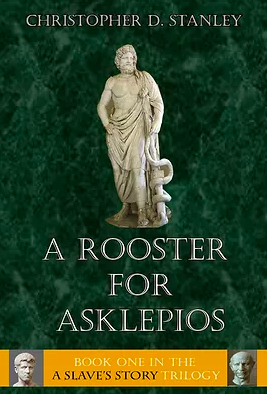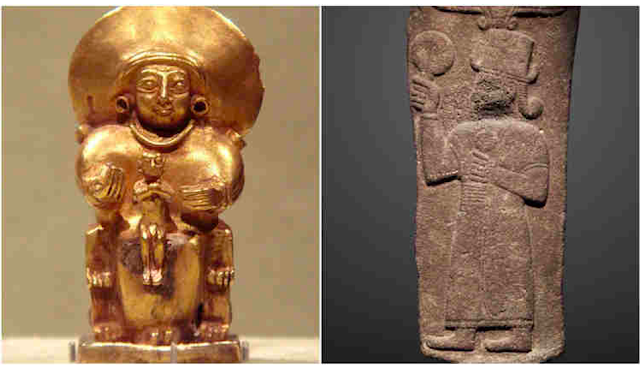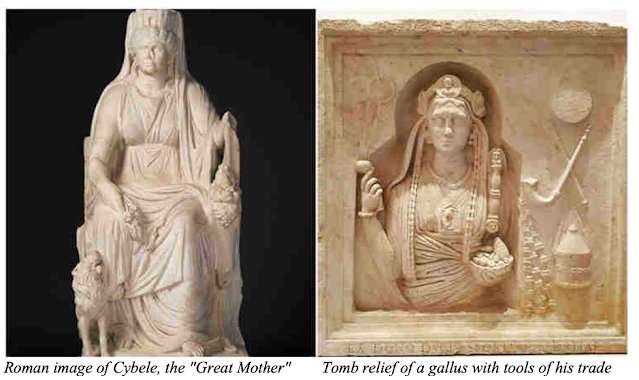A Rooster for Asklepios
(A Slave's Story Trilogy, Book 1)
By Christopher D. Stanley
Publication Date: May 23rd 2020
Publisher: Amelia Books
Page Length: 522 Pages
Genre: Historical Fiction
Marcus, a slave in the household of Lucius Coelius Felix, enjoys a better life than most slaves (and many free citizens) as the secretary and accountant of a wealthy aristocrat. His master is rising in the civic life of the Roman colony of Antioch-near-Pisidia (central Turkey), and his responsibilities and income are growing as well. If this continues, he could soon earn enough to buy his freedom, set up a small business, and even marry.
Then misfortune strikes, and his master falls into a deep depression that is exacerbated by a nagging illness that his physician is unable to cure. The future looks bleak until the physician receives a dream from the healing god Asklepios calling Lucius to travel hundreds of miles across western Asia Minor to his sanctuary at Pergamon for treatment and, he hopes, a cure.
Accompanied by Marcus and his new wife Selena, Lucius embarks on a long and eventful journey in which both master and slave encounter people and ideas that challenge long-held beliefs about themselves, their society, and the world around them. Values are questioned, loyalties tested, and identities transformed in a story that brings to life a corner of the Roman empire that has been neglected by previous storytellers.
Women Rule! Mighty Goddesses of Asia Minor
By Dr. Christopher D. Stanley
All three book titles in my A Slave’s Story historical fiction trilogy include the name of a male Greek or Roman deity who was known for his power.
Book One (A Rooster for Asklepios) honors the Greek god of healing who was one of the most beloved deities of the Greco-Roman world because he used his power to restore health to those in need. He plays a vital role in my story as my characters make a life-changing journey across Asia Minor to seek healing at one of his temples.
Book Two (A Bull for Pluto) employs the Roman
name for the lord of the underworld, a god so fearsome that people hardly dared to pronounce his name. A crucial incident in my story takes place at a festival given in his honor at the spa city of Hierapolis in west central Asia Minor, a site that many people regarded as the entrance to the underworld. Life hangs in the balance.
name for the lord of the underworld, a god so fearsome that people hardly dared to pronounce his name. A crucial incident in my story takes place at a festival given in his honor at the spa city of Hierapolis in west central Asia Minor, a site that many people regarded as the entrance to the underworld. Life hangs in the balance.
Book Three (A Ram for Mars) invokes the Roman deity of war and conquest, the epitome of male valor and destructive power. His presence hovers in the background as my story shifts from Asia Minor to the land of Israel in the years leading up to the Jewish Revolt against the Romans in 66-73 AD. Opposing him is another god of war, the God of the Bible, the Lord of Hosts, whom the Jewish rebels invoke on their side. My story follows some very ordinary people who are caught in the middle of this epic conflict.
Despite these titles, male deities are not the only ones who exercise power in my novels. Two powerful goddesses, Artemis and Cybele, also receive significant attention at various points in my story. Both embodied the primal forces of life and nature, making them more powerful than any male deity to the people of this region. Both had deep roots in the history and culture of Asia Minor where the first two books of my trilogy take place.
Long before the coming of the Greeks and Romans, the people of Asia Minor (modern Turkey) honored powerful earth goddesses as a central element of their religion. The oldest known image of a goddess from this region dates to 14,000 BCE. The two images above, which date to around 6000 BCE, were found at a site in south central Turkey called Çatalhöyük. Comparisons with other cultures have led most interpreters to interpret them as fertility goddesses, but this idea has been contested in recent years. Their corpulent forms more likely symbolized prosperity in an era when food security could not be taken for granted. Note the feline figures on either side of the woman on the right—they will reappear in later images of goddesses from the region.
The period of the Hitttes (2nd millennium BC) introduced to the historical record an influential category of ruler goddesses. These goddesses did not rule alone—they were part of a broader pantheon of deities, and most were consorts of male deities. But their duties extended much farther than fertility. The images above show the sun goddess of Arinna, who during the Old Hittite era was the chief deity of the state. The figure on the right is the goddess Kubaba, who was originally a human queen in Mesopotamia but over time became the chief goddess of the neo-Hittite state. From this era forward, ruler goddesses played a central role in the religious life of Asia Minor.
In the 1st millennium BC, the goddess Kybele (or Cybele), whose origins can be traced to the region of Phrygia in central Turkey, emerged as the preeminent deity of Asia Minor. Her name may have been derived from the earlier Hittite goddess Kubaba, but her traits and powers were much broader that hers. She embodied in herself all of the powers of wild nature, ruling over both animals and humans. She is usually portrayed seated on a throne and wearing a turreted crown, with lions on either side or pulling her in a chariot, as shown in the images above. All of these emblems symbolized authority, both divine and human.
Temples of Kybele could be found all over Asia Minor by the middle of the 1st millennium BC, and in many other places as well, including Athens. She was also served by wandering priests called galli who carried her statue around with them and engaged in frenzied public rituals that involved music and dancing and culminated with one or more of them castrating themselves as a final act of dedication. The Romans were disgusted by these bizarre rituals, but they were so impressed with Kybele's power that they conscripted her to assist them in their war against Carthage, erecting a temple for her in Rome in 191 BCE. She was the first non-Roman goddess to be worshipped in this way in Rome.
As Greeks and Romans came into contact with Kybele and her powerful reputation, they began to assimilate her with their own goddesses in both appearance and powers. The image on the left is the famous cult statue of Artemis from her temple near Ephesus. In Greek myth and sculpture, Artemis is a huntress who is shown running with flowing robes in company with wild animals. This image is nothing like that. The same is true for the statue of Aphrodite on the right, which is vastly different from the standard Greek image of her as a voluptuous nude. Both include elements commonly associated with Kybele, especially the wild animals on their garments and the turreted crown. Both were also worshiped as the patron deity and protector of their cities, following the pattern of Kybele and other ancient goddesses of Asia Minor.
Both Kybele and Artemis appear in the first two books of my A Slave's Story trilogy. Book One describes a visit to the temple of Artemis at Ephesus, where my characters tour the site, learn about its history, and present an offering to the goddess seeking her favor on their journey. Book Two depicts a festival for Kybele, Apollo, and Pluto that takes place in Hierapolis, a city famed for its healing springs. The story includes two accounts of rituals performed by the priests of Kybele, the galli, that are so bizarre that modern people find them hard to comprehend. But they really happened! You have to read the books to find out what they did.
50% off Book One for a Limited Time Only
(15th - 30th December 2021)
Including #Kindle and #Paperback
Book Two
CHRISTOPHER D. STANLEY is a social and religious historian who studies and writes about early Christianity and the Greco-Roman world. He recently retired as a professor at St. Bonaventure University in western New York. He has written or edited six books and dozens of professional articles on early Christian texts and history and presents papers regularly at conferences around the world. The trilogy A Slave's Story, which grew out of his historical research on first-century Asia Minor, is his first work of fiction. He is currently writing an academic book about healing practices in the Greco-Roman world, a subject that plays a central role in his trilogy.
Connect with Christopher:















No comments:
Post a Comment
See you on your next coffee break!
Take Care,
Mary Anne xxx